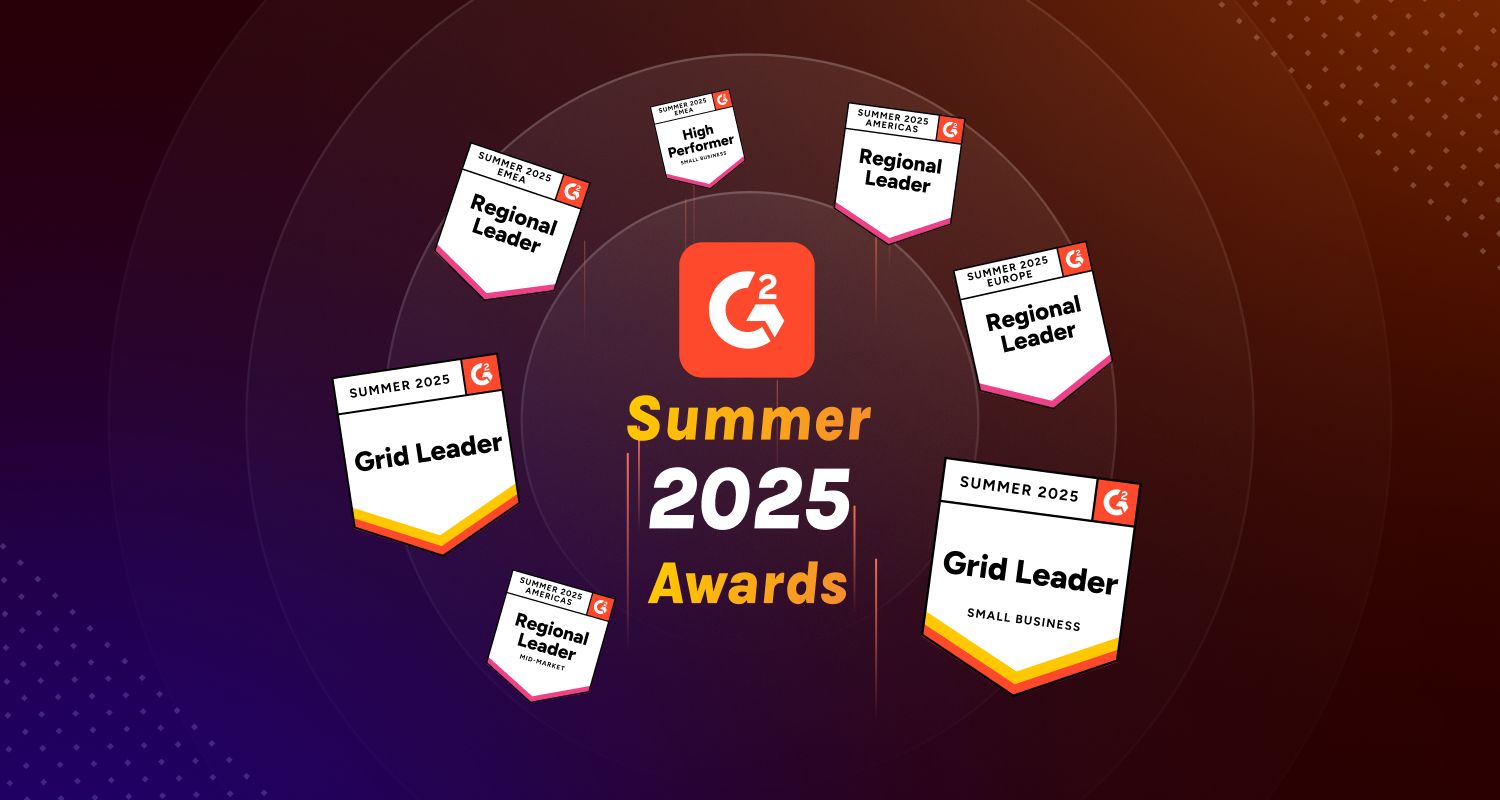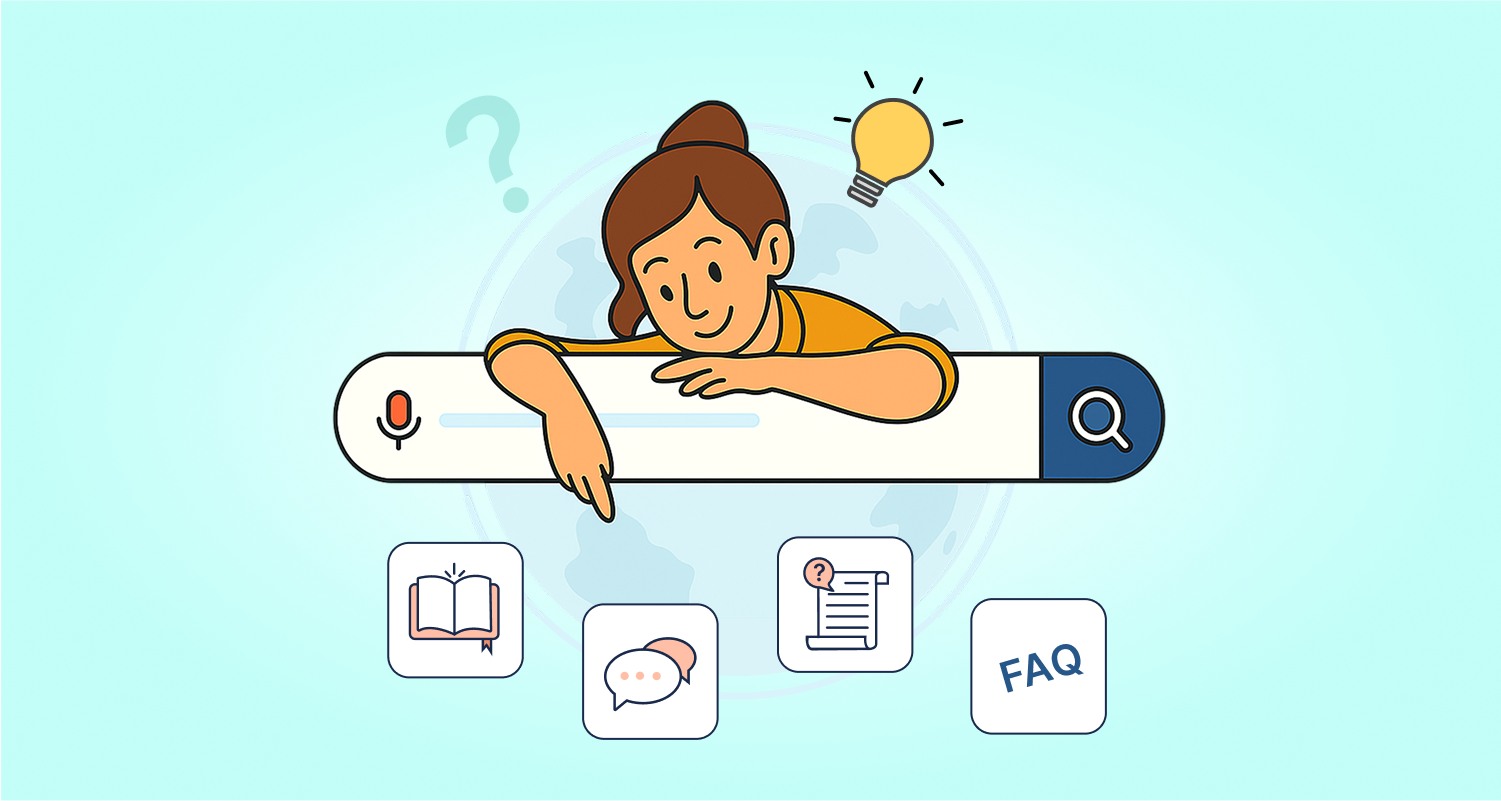Delivering great customer service isn’t just about being available, it’s about choosing the right support model that aligns with your customers’ communication preferences and your team’s capacity to deliver support effectively.
As businesses grow and customer expectations evolve, so does the need to implement the most effective types of customer service for your specific customer needs.
But with so many support model options available, how do you choose the one that best suits your support team, your product, and your customers?
Let’s break down the most common types of customer service and support models, with insights to help you determine the best fit for your business.
What is a customer service or support model?
A customer service or support model is a structured framework that defines how a business delivers assistance to its customers.
It guides how support agents respond to questions, handle complaints, and resolve issues at every stage of the customer journey.
A well-designed support model also allows organizations to scale service delivery effectively, whether through human agents, self-service tools, or AI-powered systems.
Ultimately, it serves as a blueprint for delivering seamless, efficient, and positive customer experiences.
Why choosing the right types of customer service model is important?
Since every customer has unique preferences, your support approach should reflect that diversity.
Some customers may prefer speaking directly with support agents over the phone, while others might opt for live chat for real-time assistance or self-service options that let them find answers independently.
Choosing the right support model helps ensure that every interaction is timely, efficient, and tailored to customer expectations, driving higher satisfaction, stronger loyalty, and long-term business success.
It also allows your support team to allocate resources more effectively and prioritize channels that deliver the most value.
Key types of customer service and support models
Choosing the right support channels and models is essential for meeting customer demands and improving service efficiency.
Each option offers unique benefits and challenges depending on your business size, industry, and customer preferences.
Let’s take a look at the most popular customer support models, see their advantages and disadvantages, and discover use cases for each.
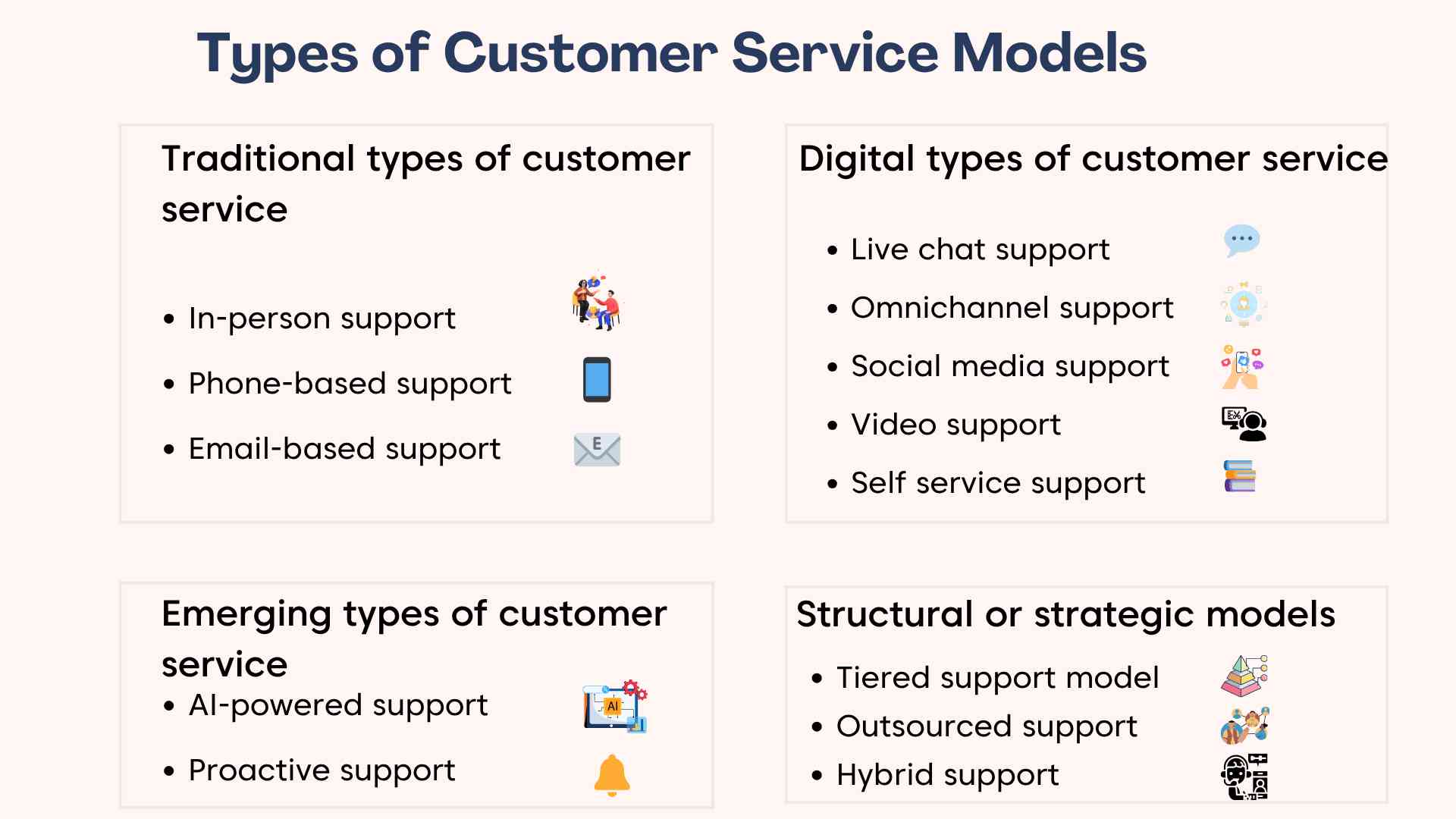
Traditional types of customer service
These are traditional methods of providing customer support that have been used for years, such as phone and in-person service, and are still valued for their reliability and personal touch.
In-person support
In-person support refers to a customer service model where assistance is provided face-to-face at physical service locations, such as retail stores, service centers, or offices.
This approach enables direct, physical interaction, which makes support effective for handling complex issues, building trust, and offering hands-on assistance.
| Pros | Cons |
| Personalized interaction: Fosters empathy and clear communication.
Ideal for complex or sensitive issues: Handles technical or sensitive matters more effectively. Builds trust: Strengthens relationships and confidence. |
High costs: Physical locations and staffing are expensive.
Limited access: Availability depends on location and business hours. |
Email-based support
Email-based support is a customer service method where businesses assist customers through email communication.
It allows customers to send requests at any time and receive a detailed response later, making it ideal for complex inquiries that may need attachments, screenshots, or thorough explanations.
Despite the rise of newer technologies, email remains the primary communication method for about 95% of businesses, thanks to its reliability and flexibility.
| Pros | Cons |
| No waiting: Customers can send queries anytime and check back later.
Clear records: Written history makes follow-ups and accountability easier. Good for complex or non-urgent issues: Allows thoughtful, detailed responses. |
Slower replies: Lack of real-time interaction can cause delays.
Hard to scale: Managing large volumes efficiently requires strong systems. |
Phone-based support
Phone support is a customer service method where customers interact directly with support agents over the phone to receive help.
It remains a key part of many businesses’ customer experience strategy, even with the rise of digital channels.
Phone conversations offer real-time communication and a personal touch, making them especially valuable for complex issues or situations that require empathy and clarity.
| Pros | Cons |
| Real-time help: Issues are resolved quickly through live conversation.
Personal touch: Direct interaction builds trust and rapport. Empathy in tone: Voice conveys understanding during sensitive situations. |
Hold times: Waiting or transfers can frustrate customers.
Less global-friendly: Time zones and language differences limit accessibility. |
Digital customer service types
These digital support models rely on the internet or digital communication channels.
Live chat support
Live chat support is a type of customer service where agents provide real-time assistance to customers directly on websites or apps through instant messaging.
With live chat widgets, customers can easily connect with agents while browsing, without ever leaving the site.
For example, with BoldDesk’s live chat software, businesses can easily engage website visitors instantly and provide quick assistance without interrupting their browsing experience.

This seamless interaction allows for quick answers, faster issue resolution, and a smooth, uninterrupted user experience.
| Pros | Cons |
| Instant help: Resolves issues quickly, reducing drop-offs.
Efficient: Agents can handle multiple chats at once. Saved chats: Transcripts aid follow-up and training. |
Not ideal for complex issues: May need escalation to other channels.
Complex issues are harder to resolve: Live chat is less effective for troubleshooting in-depth technical or multi-step problems. |
Self-service support
Self-service support is a customer service model that enables users to find answers and resolve issues independently, without needing to contact a live support agent or representative.
- This is made possible through a range of digital tools and resources, such as knowledge bases, FAQs, video tutorials, and user guides.
- A complete self-service experience also includes access to a customer self-service portal, where users can log in to track support requests, manage their accounts, and access personalized content.
For example, BoldDesk includes features like knowledge base software for businesses to create comprehensive self-service resources and provide their customers with a customizable self-service portal.

- In addition, community-based support forms part of self-service, where businesses offer interactive forums or platforms for customers to interact, ask questions, share tips, and work together to solve problems independently.
| Pros | Cons |
| Always available: Customers get help anytime without waiting.
Highly scalable: Handles many users at once, great for growth. Less agent load: Frees agents for complex or urgent issues. |
Content quality matters: Poor or outdated info can frustrate users.
Needs regular updates: Must stay current to remain effective.
|
Omnichannel support
Omnichannel support is a customer service model that delivers a seamless, connected, consistent experience across every communication channel.
This includes phone, email, live chat, social media, SMS, and more, regardless of how or where the customer interacts with a business.
What makes omnichannel support powerful is its ability to unify customer conversations from these various channels into a single platform.
For instance, BoldDesk’s omnichannel customer service software centralizes all interactions, allowing agents to access complete conversation histories and customer context in one place.

This unified view helps support teams respond more efficiently, maintain continuity across channels, and deliver more personalized support experiences, without requiring customers to repeat themselves.
| Pros | Cons |
| Seamless experience: Consistent support across all channels.
Customer flexibility: Easy to switch channels without losing context. Complete history: Agents see full interaction records for better service. |
Complex setup: Integrating and managing channels takes effort.
Tech requirements: Needs advanced tools to work effectively. |
Social media support
Social media customer service is a way for businesses to engage with customers directly through platforms like Facebook, Instagram, X (formerly Twitter), and others, providing support, answering questions, and resolving issues in real time.
By responding to comments, direct messages, reviews, and questions in real time, companies can resolve issues and offer guidance where customers are already active online.
This approach not only enhances convenience but also strengthens brand presence and trust in the digital space.
| Pros | Cons |
| Customer convenience: Support on familiar platforms.
Public trust: Open resolutions build brand credibility. Quick and transparent: Encourages fast, visible responses. |
Requires constant monitoring: Needs 24/7 attention.
Reputation risk: Negative posts can spread quickly. |
Video support
Video support is a customer service model that uses live video calls to connect support agents with customers in real time.
It allows for face-to-face communication without requiring either party to be physically present, making interactions more personal, visual, and effective, especially when handling complex or technical issues.
Companies can integrate their help desk with video communication tools like MS Teams and Zoom to visually guide customers through troubleshooting steps, demonstrate product usage, or offer personalized consultations for faster and clearer issue resolution.
| Pros | Cons |
| Trust-building: Strengthens customer relationships and trust.
Real-time emotional insights: Agents can see facial expressions and body language to better understand customer sentiment. Convenient support: Gives help without needing to travel. |
Tech-dependent: Requires a stable internet connection and compatible devices.
Limited scalability: Not ideal for high-volume or low-complexity support needs. |
Emerging types of customer service
These are newer or technology-driven innovations transforming the customer service landscape.
AI-powered support
AI-powered support is a customer service solution that uses artificial intelligence technologies like virtual assistants and machine learning to enhance interactions with customers.
It helps answer questions, resolve issues, and provide personalized assistance without needing constant human involvement.
AI-powered customer support can be divided into three main types.
- AI Agents are like smart assistants that talk directly to customers, answering questions, solving simple issues, and working 24/7.
- AI Copilot helps human support agents by suggesting replies, finding useful info quickly, and showing customer details during a conversation.
- AI Actions are customizable tools that help agents automate and enhance their support tasks using AI-driven prompts. They enable features like response reviews, ticket summarization, and sentiment analysis directly within the ticket interface.
| Pros | Cons |
| Scalable: Handles high volumes without more staff.
Always available: 24/7 availability boosts responsiveness. Efficient operations: Tools optimize staffing and resources. |
Complex setup: Requires time and tech investment.
Lacks empathy: Some issues still need a human touch. |
Proactive support
Proactive customer service is when a company takes initiative to help customers before they ask for help or before an issue arises.
This can involve onboarding messages, usage tips, system alerts, or personalized check-ins based on customer preferences.
| Pros | Cons |
| Issue prevention: Reduces support volume and frustration.
Operational efficiency: Frees agents for complex cases. Faster resolution: Early detection speeds up fixes. |
Data-dependent: Needs tools and analytics.
Limited scope: Can’t predict every issue. |
Other/structural or strategic types of customer service
These customer service models refer more to how support is structured or delivered rather than the channel itself.
Tiered support model
Tiered support is a structured approach to customer service where support is divided into levels (or tiers) based on the complexity of the issue and the expertise required.
Each tier is responsible for handling different types of customer inquiries, ensuring efficient resolution, and proper resource allocation.

- Tier 0 involves self-service options like FAQs, knowledge bases, and tutorials, allowing customers to find answers independently.
- Escalation to Tier 1 through Tier 4 depends on the issue type and complexity, with each level equipped to handle progressively more advanced problems.
Hybrid customer service model
This is a customer service model that combines multiple support channels, such as phone, email, live chat, social media, and self-service, into a flexible system that allows customers to choose how they want to interact with your business.
It emphasizes integrating all channels into a seamless experience and providing various options without necessarily connecting them in real time.
Dedicated/outsourced support model
This model involves hiring third-party companies or external teams to handle some or all of your customer support processes.
Outsourcing customer service can effectively manage large volumes of inquiries, provide 24/7 coverage, and assist customers in multiple languages.
How to choose the perfect types of customer service
To deliver exceptional service, it’s important to adopt a flexible approach that balances your business capabilities with customer demands.
Rather than relying on a single method, consider offering a mix of service types tailored to different situations and preferences.
With so many types of customer service and support models available, how do you determine which combination will work best for your specific business demands?
Here are the key factors to consider when choosing the right customer service model:
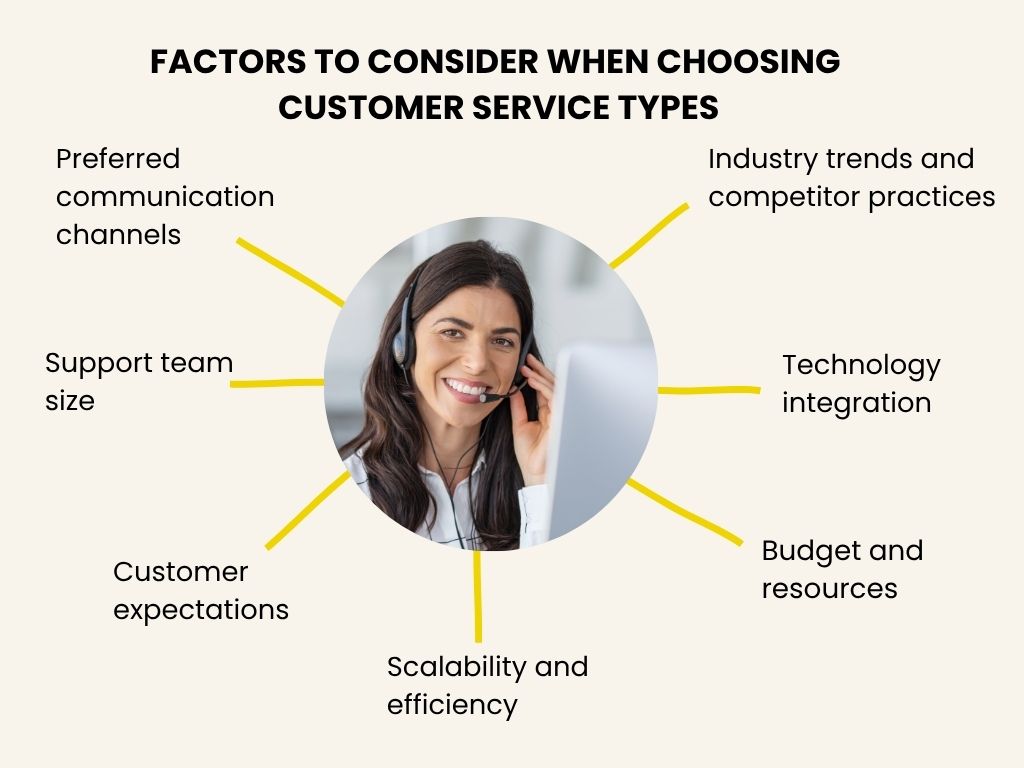
- Preferred communication channels: Identify which channels your customers use most, whether it’s live chat, email, phone, social media, or self-service portals.
- Support team size and skill set: Match the complexity of different customer service types with the size and expertise of your support team. Smaller teams may benefit more from automated tools and self-service options, while larger teams can manage omnichannel support more easily.
- Customer expectations and behavior: Analyze customer feedback and preferences to understand what they value most like speed, personalization, convenience, or availability. Then, choose service types that align with these preferences.
- Scalability and efficiency: Opt for customer service types that can grow with your business without compromising quality. Solutions like AI-powered live chat can help scale support without adding headcount.
- Budget and resources: Consider the cost of implementing and maintaining each support model. Prioritize options that offer high impact with manageable investment, especially if you’re working with limited resources.
- Technology integration: Ensure that your chosen customer service types integrate well with your existing systems, such as your CRM or help desk software, for a seamless and consistent customer experience.
- Industry trends and competitor practices: Stay informed about evolving customer service trends and benchmark against successful competitors to remain relevant and competitive.
What’s the right customer service model for your support team?
Navigating through the numerous customer support models can be daunting. However, with the right tools and skills, businesses can streamline their support strategies effectively.
Businesses can leverage BoldDesk®’s comprehensive, flexible, and simple-to-use features that support most types of customer service, including email support, real-time live chat, omnichannel support, self-service portals, and social media integration.
By leveraging BoldDesk’s flexible features, you can streamline your customer support operations, ensuring timely and effective customer interactions across all channels.
Contact us to upgrade from traditional support and deliver faster, smarter service with BoldDesk’s all-in-one customer service platform.
Was this an interesting article to you? Please share your ideas and opinions in the space provided for comments below.
Related articles
- 12 Types of Customers and How to Win Them
- Online Customer Service [Best Ways to Improve It]
- From AI to Personalization: 15 Customer Service Trends to Watch in 2025
Frequently Asked Questions (FAQs)
Yes! Many companies can use a mix of methods to help customers. They can offer self-service options for frequently asked questions, AI tools for quick answers, and live agents for more complicated issues.
Using a model that doesn’t match customers’ wants. If customers expect quick, easy support but your system is slow and complicated, you will lose them.
Another mistake is not adapting. Customer needs change, and your service model should change too.

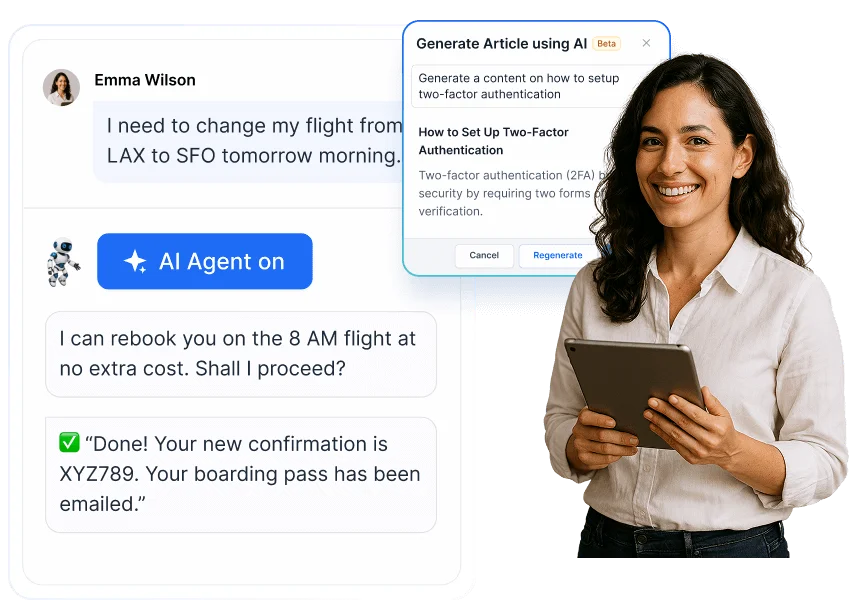

















 Email Ticketing System
Email Ticketing System Shared Inbox Software
Shared Inbox Software Multi Brand Help Desk
Multi Brand Help Desk Internal Help Desk Software
Internal Help Desk Software Trouble Ticketing Software
Trouble Ticketing Software Mobile Help Desk
Mobile Help Desk 











